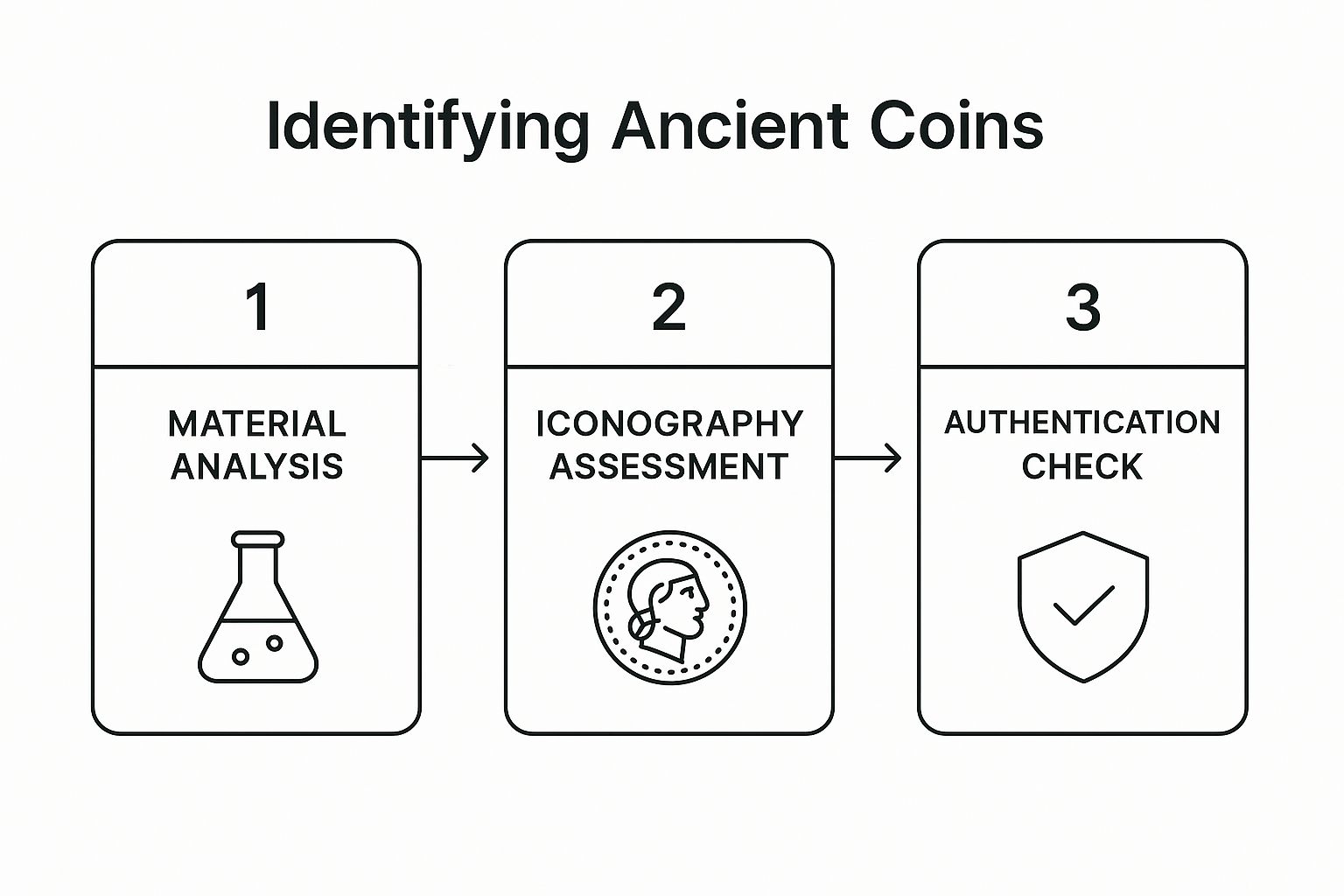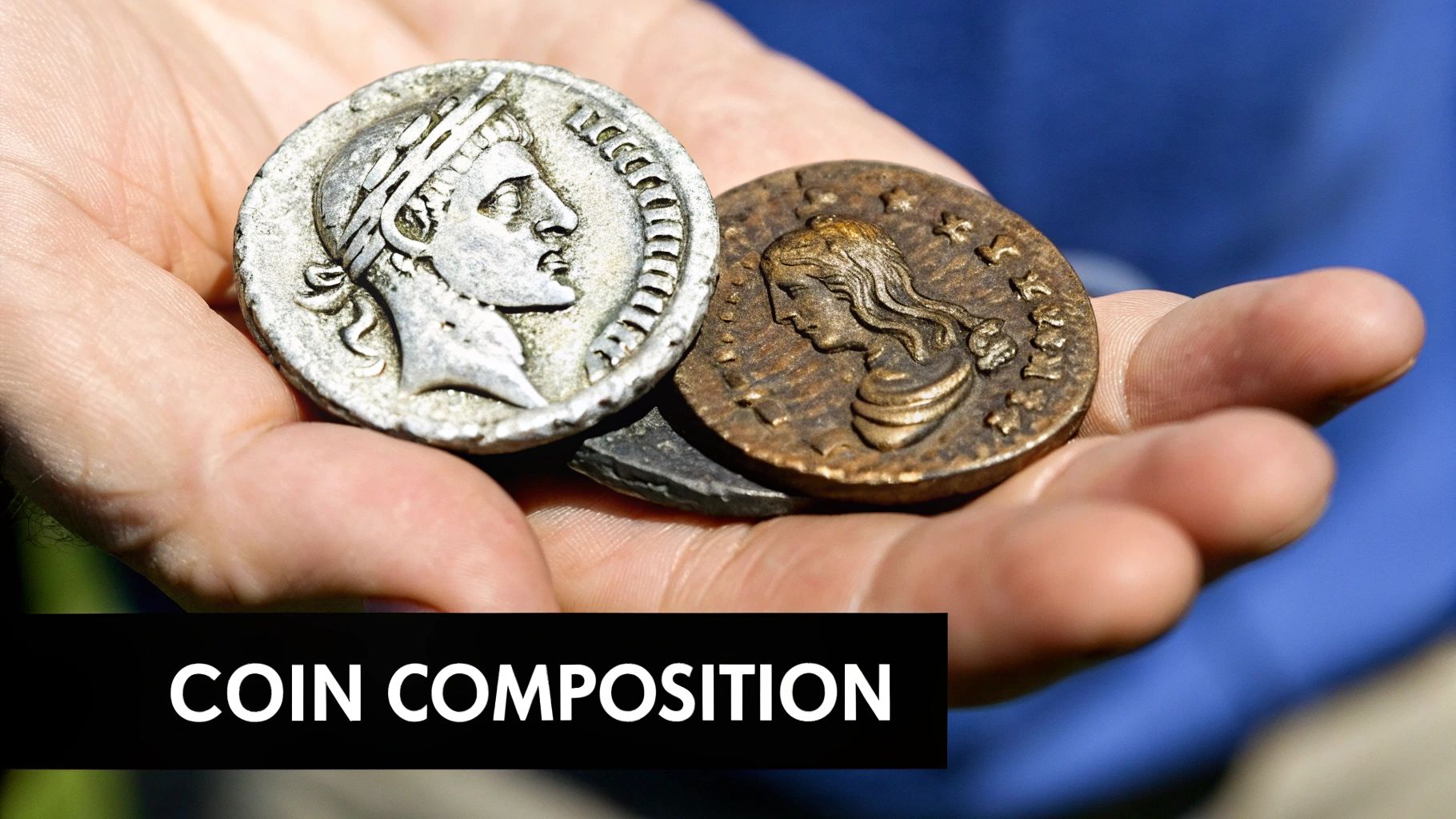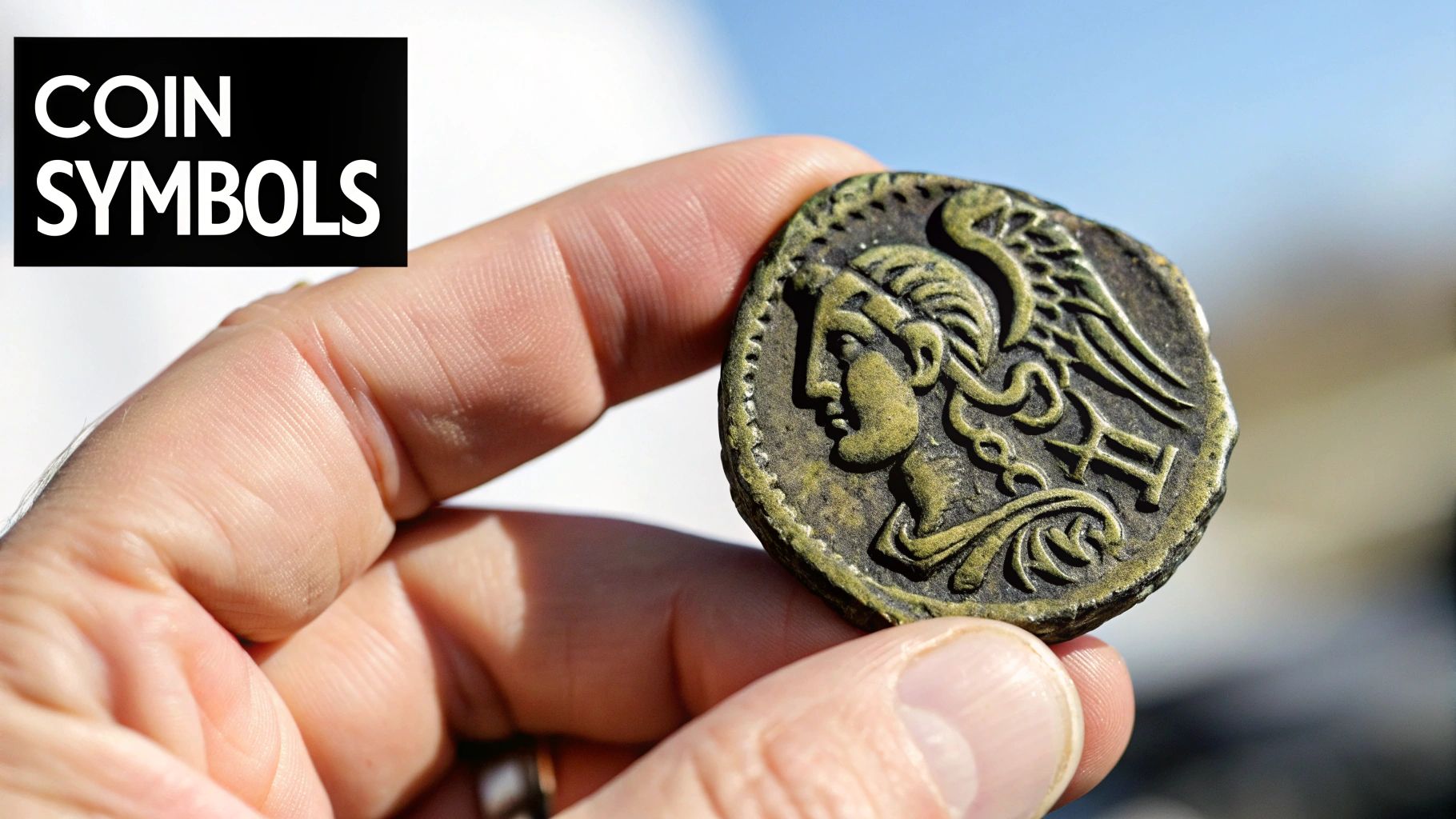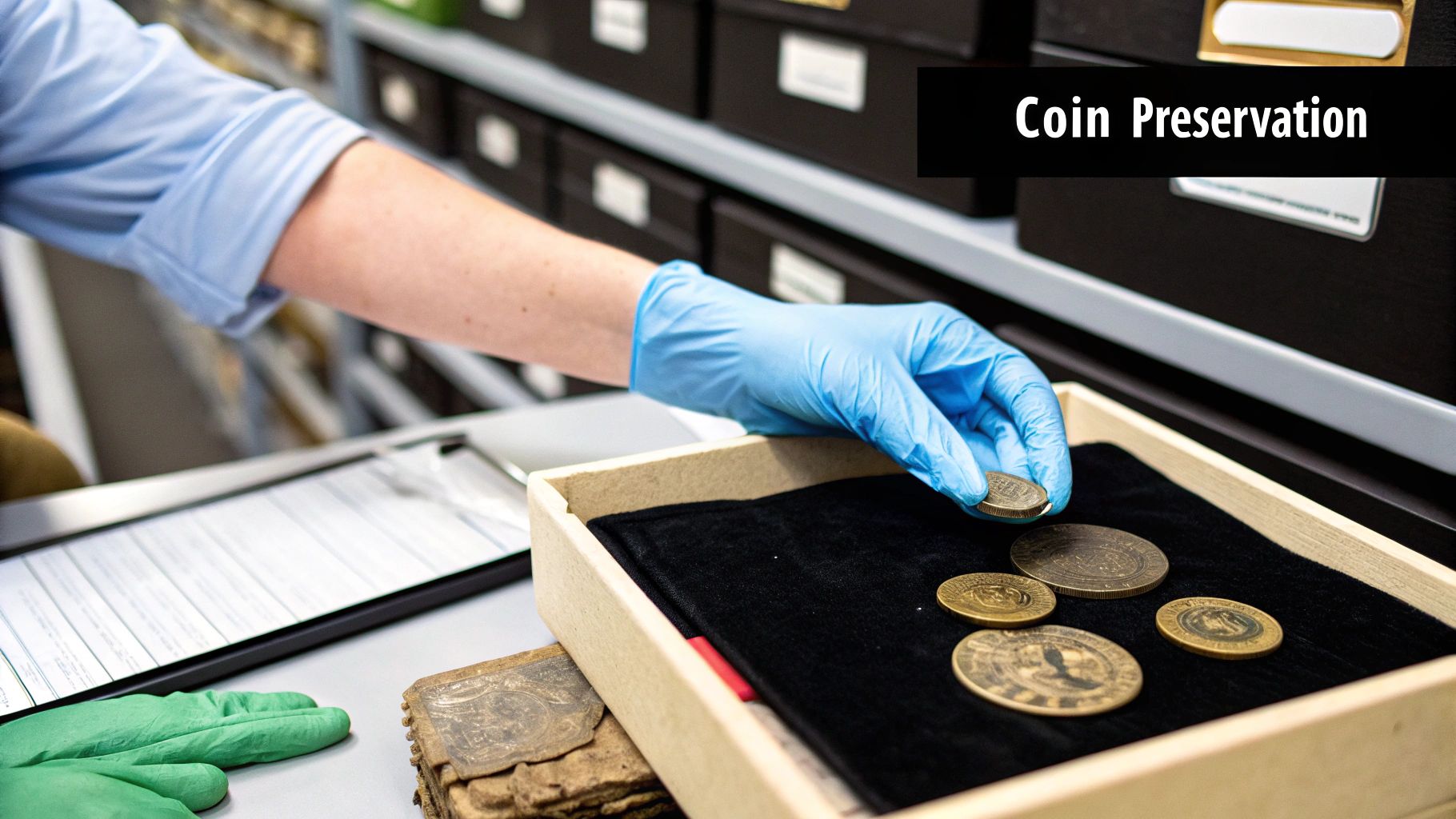Holding a piece of history is one thing; understanding it is another. To properly identify an ancient coin, experts don't just jump in. We perform a quick 'triage' to assess the coin's condition, dominant features, and likely metal.
This initial assessment creates a roadmap for the whole identification process, turning what looks like a confusing artefact into a solvable puzzle.
Your First Look at an Ancient Coin
When you first handle an unknown coin, those initial observations are absolutely crucial. Forget complex tools for a moment. The goal is to perform a rapid visual and tactile assessment that will guide every subsequent step you take.
This foundational 'triage' helps you avoid dead ends and points you towards the right resources from the very start. Think of it as gathering the primary evidence before you start building your case. It helps you organise your thoughts and sets a logical course. Is the coin heavy and yellow-gold, or is it a lighter, silvery colour? Is it thick and chunky like a Roman sestertius, or thin and irregular like some early Greek issues? These first impressions are surprisingly informative.
Initial Coin Assessment Checklist
Before diving deep, a quick check of the basics can narrow down the possibilities immensely. The table below outlines the first things a numismatist would look at. It’s a simple checklist to get you started on the right foot.
| Characteristic | What to Look For | Why It Matters |
|---|---|---|
| Overall Condition | Is the design crisp or worn smooth? Look for corrosion, damage, or cleaning scratches. | Condition directly impacts how much detail is left to identify and affects the coin's historical and market value. |
| Dominant Features | What image stands out? A portrait, animal, building, or abstract symbol? | This is your biggest clue. Portraits often mean Roman or Hellenistic, while symbols might suggest earlier periods. |
| Apparent Metal | Note the colour and weight. Is it gold, silver, bronze, or a mixed alloy (billon)? | The metal helps place the coin in an economic context—gold for the wealthy, bronze for everyday transactions. |
Following this simple process ensures you gather the most important clues first, making the rest of the identification far more straightforward.
The Importance of a First Look
This preliminary triage is much more than just a casual glance; it's a diagnostic process. For instance, identifying the metal can immediately place the coin within a certain economic context. Likewise, recognising a clear portrait points you towards Roman or Hellenistic coinage, while abstract symbols might suggest earlier Greek or Celtic origins.
This structured approach, moving from the metal to the key images, ensures you don't miss crucial clues during your initial examination.

This systematic first look prevents you from getting lost. It's the difference between randomly searching for clues and following a clear, evidence-based path.
A common mistake for beginners is to jump straight to trying to read worn inscriptions. By first assessing the coin’s physical nature and primary symbols, you gather essential context that makes deciphering text much easier later on.
This disciplined start makes the entire journey of identification more efficient and rewarding. For a deeper dive into the methodology, you can read our detailed guide, which provides more expert tips for success in identifying ancient coins.
Uncovering Stories in Metal and Weight

The very substance of a coin—its metal, weight, and size—tells you so much about its origins, the economic reality of its time, and the power of its issuer. Getting to grips with these physical traits is a foundational skill. It's what takes you from being a casual observer to a serious analyst when you set out to identify ancient coins.
Think of the metal as an instant clue to a coin’s purpose. A heavy gold aureus, for instance, wasn't for buying a loaf of bread; it was for paying legions or settling significant state debts. A silver denarius was a common high-value coin for commerce, while a chunky bronze sestertius was the real workhorse of the Roman marketplace, used for all sorts of everyday transactions.
This distinction alone helps you frame the coin's historical context before you even squint at the emperor’s portrait. An experienced numismatist can often feel the difference in density and composition, but developing a good eye for colour and lustre is a fantastic start.
The Significance of Weight and Diameter
While colour gives you a hint, a coin's precise weight and diameter are your hard data points. These measurements aren't just technical details; they are absolutely critical identifiers. Ancient mints followed surprisingly strict standards, and knowing what to expect can dramatically narrow down your search.
For this, a simple digital scale that’s accurate to at least two decimal places (0.01g) and a set of callipers are invaluable tools. A Roman denarius from the early Empire, for example, should weigh in somewhere around 3.8 to 4.0 grams. If your silver coin weighs a lot less, it might be from a later period, a different denomination altogether, or even a contemporary forgery.
The process of debasement, especially during the Roman Empire's 3rd Century Crisis, is a key historical marker. Emperors would reduce the silver content in coins to fund wars and expenses. A coin that looks silver but is light for its size, like an antoninianus, tells a story of economic turmoil.
Common Metals and What They Suggest
The metal itself can point you towards specific cultures and time periods. Getting familiar with the primary metals used in different eras is a massive leap forward in your ability to identify ancient coins.
- Gold (Aureus, Stater): Always reserved for the highest denominations across Greek and Roman civilisations. Its presence indicates significant wealth and state-level transactions.
- Silver (Denarius, Drachm): This was the backbone of most ancient economies. The purity of the silver is often a great indicator of the economic health of the state that issued it.
- Bronze/Copper (Sestertius, As): Used for daily commerce. These coins often develop a distinct surface layer, or patina, which can range from green to brown and is a cherished sign of authenticity.
- Billon: A mixture of silver and a base metal like bronze. It was widely used during periods of economic decline to stretch precious metal reserves, making it a tell-tale sign of specific, often turbulent, historical periods.
Reading the Symbols and Iconography

Once you’ve got a feel for a coin’s physical properties, the real discovery begins with its art. You have to remember, ancient coins were the mass media of their day. They were powerful tools for propaganda, religious expression, and cultural pride. Every single image was deliberately chosen to send a clear message, making the ability to identify ancient coins from their symbols a fundamental skill for any collector.
The imagery on a coin, which we call its iconography, is split between its two sides. The obverse (heads) is almost always dedicated to a portrait. For Roman coins, this is typically the reigning emperor or perhaps a member of the imperial family. If you can recognise the face of Augustus, Nero, or Hadrian, you can instantly place that coin in its correct historical window.
The reverse (tails) is where the real story unfolds. This side was used to commemorate military victories, celebrate the virtues of the emperor, honour gods and goddesses, or even announce the construction of a new public building. Think of it as a miniature billboard, broadcasting a message across an entire empire.
Common Symbols and Their Meanings
The more coins you handle, the more you’ll start to recognise a recurring visual language. Certain symbols pop up again and again across different reigns and regions, each carrying a specific, widely understood meaning. Learning this symbolic vocabulary is absolutely essential for piecing together the coin's full story.
Here are a few common examples you’ll almost certainly encounter:
- Eagle: Often shown clutching a lightning bolt, this is a powerful symbol of Jupiter. By extension, it represents Roman military might and the emperor’s authority.
- Cornucopia: This is the "horn of plenty," overflowing with fruit. It represents prosperity, abundance, and the fertility of the empire—a message of peace and economic good times.
- Ship's Prow (Rostrum): A clear reference to naval power and victory at sea. This became a really prominent symbol after major maritime conquests.
- Goddess Ceres: Usually depicted holding stalks of grain or a torch, she represents agriculture and bountiful harvests, a critical concern for any ancient state.
These are just a handful of the hundreds of symbols you might find. Each one adds a crucial piece to the puzzle of the coin’s purpose and where it came from.
When you start to see coins not just as money but as carefully crafted historical documents, their true significance comes alive. A depiction of the Colosseum isn't just a picture; it's a celebration of a monumental achievement, broadcast to every corner of the Roman world.
Decoding Portraits and Deities
Even the portraits themselves are loaded with information. A Roman emperor shown wearing a radiate crown (a crown with spikes representing the sun's rays) often indicates a double-denomination coin, like an antoninianus being worth two denarii. The classic laurel wreath, on the other hand, was the ultimate symbol of victory and supreme authority.
Greek coins often featured gods and goddesses instead of mortal rulers. A coin with the helmeted head of Athena is almost certainly from Athens, while the winged horse Pegasus points strongly towards Corinth. You’ll also see mythological beasts like the Griffin or the Minotaur, which act as powerful clues linking a coin to a specific city-state and its founding myths.
By cross-referencing these portraits and symbols with online databases, you can begin to confidently identify ancient coins and truly understand the stories they were minted to tell.
Getting to Grips with Inscriptions and Mint Marks
The lettering on an ancient coin is your most direct path to a solid identification. While the pictures tell a story, it’s the inscriptions that give you the hard facts—names, titles, and even where it was made. Learning to read this text, even when it’s worn down or only partially visible, is a skill that takes you from guesswork to a methodical process.
Many new collectors feel put off by the fragmented Latin or Greek, but you don’t need to be a language scholar. It’s much more about recognising patterns. Roman coins, for example, are covered in abbreviations designed to project an emperor's power. Seeing IMP stands for Imperator (Commander), P M or PONT MAX for Pontifex Maximus (High Priest), and COS for Consul, which is usually followed by a number telling you how many times he held that office.
These titles are like a fingerprint. A coin that reads ‘IMP CAESAR TRAIANVS HADRIANVS AVG’ tells you you’re holding a piece from Hadrian's reign. Even a small snippet of that can be enough to kickstart your search in a reference database.
Pinpointing the Coin's Birthplace
Beyond the grand imperial titles, some of the most vital letters on a coin are the mint marks. You’ll usually find these small codes on the reverse, tucked away in an area called the exergue (just below the main design). Understanding these is absolutely key for telling a common coin from a rare one, which can massively affect its historical significance and value.
A Roman coin from the later Empire might carry a code like ‘TR’ or ‘PLG’. These aren't just random letters; they are official shortcuts for the city where the mint was located.
- TR stands for Trier (Augusta Treverorum), a major mint in what is now Germany.
- LUG or PLG points to Lugdunum (Colonia Copia Claudia Augusta Lugdunum), today's Lyon in France.
- SIS means it came from Siscia, a hugely productive mint in modern-day Croatia.
- ALE tells you it was struck at the famous mint of Alexandria in Egypt.
Learning to spot these marks allows you to place a coin’s origin with incredible accuracy, adding a whole new layer to its story.
Putting All the Pieces Together
Sometimes, you’ll find letters that aren’t a title or a mint mark. A classic example on Roman bronze coins is the prominent SC on the reverse. This stands for Senatus Consulto, or "by decree of the Senate." It was a way of showing that while the emperor had control over minting gold and silver, the Senate still held its traditional authority over bronze coinage.
Think of deciphering inscriptions like solving a Sudoku puzzle. You might only have a few letters to start with, but by cross-referencing them with known imperial titles and common abbreviations, you can logically fill in the gaps and arrive at a confident conclusion.
Let's say you can just make out ‘...ANVS AVG’ on the front and see an eagle on the back with the letters ‘TR’ below it. You can already make a very educated guess. The ‘ANVS’ ending is common for many emperors (like Trajanus or Hadrianus), but the mint mark for Trier helps narrow down the time period and possibilities significantly. This methodical approach is the real secret to successfully identifying even the most challenging ancient coins.
Essential Tools for Confirming Your Find
No numismatist, no matter how seasoned, identifies coins in a vacuum. Once you've pieced together the clues from the metal, imagery, and any visible lettering, it's time to consult the experts—the reference collections that can confirm what you've found. Knowing where to look is just as vital as knowing what to look for on the coin itself.
Your first step into the world of reference materials often begins with the foundational catalogues. For Roman coins, the Roman Imperial Coinage (RIC) is the absolute bible. It's a massive, multi-volume work that meticulously categorises coins by emperor and mint. While it is the definitive print resource, it can feel a bit dense if you're just starting out.
Thankfully, we now have powerful digital tools that make this process far more approachable. For anyone serious about identifying ancient coins, these online databases are truly indispensable.
Must-Have Digital Resources
The internet is home to an incredible array of databases, and many of them are completely free to use. They let you search using the clues you’ve already gathered, like a fragment of an inscription, an emperor's name, or a specific image on the reverse.
- WildWinds: This is often the first port of call for collectors, and for good reason. It's a vast and easy-to-navigate database packed with thousands of images. You can search by ruler, keyword, and inscription, making it brilliant for quickly finding potential matches.
- OCRE (Online Coins of the Roman Empire): This is a more academic and structured project, essentially aiming to be a digital version of the RIC. It's incredibly powerful because it links coin types directly to major museum collections worldwide, giving you access to high-quality images of verified examples.
- RPC Online (Roman Provincial Coinage): If you have a hunch your coin wasn't struck at a major imperial mint like Rome or Trier, this is your go-to. It focuses specifically on the hugely diverse coinage produced across the Roman provinces.
A great professional tip is to use these resources together. Start with a broad search on WildWinds to get your bearings, then jump over to OCRE to compare your coin against verified, high-grade examples from the world's best collections.
This method of cross-referencing helps you confirm not just the type, but also gives you a better feel for the authenticity of your find. Over time, you’ll find your own rhythm, moving smoothly from the physical coin in your hand to these digital references.
The Ultimate Reference Collections
Beyond dedicated databases, the online catalogues of major museums represent the ultimate authority. These institutions house the most important, best-documented collections on the planet. The British Museum's Department of Coins and Medals, for example, holds one of the largest numismatic collections in the world, with nearly one million objects dating from the 7th century BC to today.
This makes its online collection an invaluable tool for study. You can learn more about the incredible significance of the British Museum's collection on Wikipedia.
This screenshot gives you a glimpse of the sheer scope of the museum's holdings, highlighting its role as a cornerstone of numismatic history. For any collector, these digital museum archives provide unparalleled access to authenticated specimens, often serving as the final word in the identification process.
Learning how to navigate these resources is a vital step in your numismatic journey. And if you're looking to build your own collection, you might find our guide on seven tips for buying collectable coins particularly useful.
Common Questions from New Collectors
 As you dive into the fascinating world of ancient coins, you’re bound to have questions. Everyone does. Tackling these common queries early on can help you sidestep some classic beginner mistakes and build your confidence. We’ve pulled together a few of the most frequent questions to give you some clear, practical answers.
As you dive into the fascinating world of ancient coins, you’re bound to have questions. Everyone does. Tackling these common queries early on can help you sidestep some classic beginner mistakes and build your confidence. We’ve pulled together a few of the most frequent questions to give you some clear, practical answers.
Is It Safe to Clean an Ancient Coin?
This is a big one, and the short answer is: generally, no. You should resist the urge to clean ancient coins, especially when you’re just starting out. That green or brown layer on the surface, known as the patina, has developed over centuries and is a vital part of the coin's story and authenticity.
Aggressive cleaning with harsh chemicals or stiff brushes can cause irreversible damage, stripping away fine details and destroying the coin's value. If a coin is so caked with dirt that you can't see the design, very gentle cleaning with distilled water and a super-soft brush might be an option, but only after you’ve sought advice from an expert. For most collectors, a coin with its original patina is far more desirable than one that’s been poorly cleaned.
How Can I Spot a Fake Ancient Coin?
Learning to spot forgeries is a skill that develops with experience, but there are some immediate red flags to watch for. Check the edge of the coin for a casting seam—a thin line that suggests it was made in a modern mould rather than struck. Details that look soft, "mushy," or have tiny bubbles on the surface are also classic warning signs.
An incorrect weight or diameter for that specific coin type is another dead giveaway. Always have reference material handy, comparing your piece to verified examples from reputable online databases or museum collections. If you have any serious doubts, your best bet is to ask a trusted dealer or a professional grading service for their opinion.
While every detail matters, the portrait on the obverse (the 'heads' side) and its inscription are often the best places to start your identification. Once you know the ruler, you've narrowed down the time period significantly, making it much easier to figure out the reverse imagery and mint mark.
Are Coins the Oldest Form of Currency?
That's a fantastic question that opens up the broader history of money. While coins were a huge leap forward in creating a standardised currency, they weren't the very first form of exchange. The concept of currency evolved from simple bartering systems to more abstract representations of value over a long period. If you're curious about this journey, you can explore the history of the first ever banknote, which represents another pivotal moment in how we think about wealth.
At Cavalier Coins Ltd, we are passionate about helping collectors at every stage of their journey. Whether you are identifying your first Roman denarius or seeking a rare banknote to complete a set, our curated selection offers something for everyone. Explore our extensive collection today.
Browse our collection of world coins and banknotes at CavalierCoins.com

